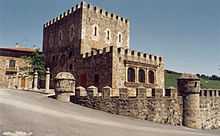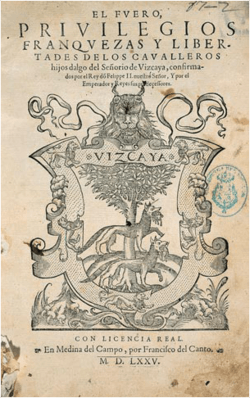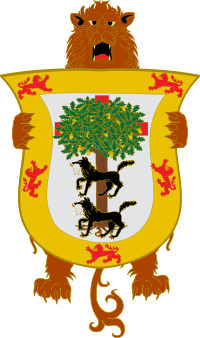Lordship of Biscay
| Lordship of Biscay | |||||
| Señorío de Vizcaya Bizkaiko jaurreria | |||||
| Vassal first of the Kingdom of Navarre, then of the Kingdom of Castile | |||||
| |||||
|
| |||||
 The Lordship of Biscay and its three constituent parts | |||||
| Capital | Bermeo (1476–1602) Bilbao (1602–1876) | ||||
| Government | Lordship | ||||
| Historical era | Middle Ages | ||||
| - | Established | 1072 | |||
| - | Abolition of the Juntas Generales | 1876 | |||
The Lordship of Biscay (Basque: Bizkaiko jaurerria, Spanish: Señorío de Vizcaya) was a period of feudal rule in the region of Biscay in the Iberian Peninsula between 1072 and 1876 and ruled by a political figure known as Lord of Biscay. It was a territory with its own political organization, with its own naval ensign, consulate in Bruges and customs offices in Balmaseda and Urduña, from the 11th Century until 1876, when the Juntas Generales were abolished. Since 1379, when John I of Castile became the Lord of Biscay, the lordship got integrated into the Crown of Castile, and eventually the Kingdom of Spain.
History
| History of the Basques |
|---|
| Prehistory and Antiquity |
| Basque Prehistory |
| Basques during Antiquity |
| Middle Ages |
| Duchy of Cantabria |
| Duchy of Vasconia |
| County of Vasconia |
| Battle of Roncevaux Pass (778) |
| Kingdom of Navarre |
| Banu Qasi |
| Lordship of Biscay |
| Basque party wars |
| Modern Age |
| Spanish conquest of Iberian Navarre |
| Basque witch trials |
| Guipuzcoan Company of Caracas |
| Carlist Wars |
| Basque nationalism |
| Basque conflict |
| Monarchs and Sovereign Families |
| Dukes of Vasconia and Gascony |
| Kings of Pamplona and Navarre |
| Lords of Biscay |
| House of Haro |
| Topical |
| Basque law |
| History of Basque whaling |
| Basque culture |
| Basque diaspora |
| Basque literature |
| Politics of the Basque Country |
| ETA |
| Timeline of Basque history |
| Basque portal |
The first time Biscay is mentioned with that name (in Spanish, Vizcaya) is in the chronics of Alfonso III of Asturias in the late 9th Century, where he mentions the regions that were repopulated unders orders of Alfonso I, and how some territories, among them Biscay, were not affected by these repopulations, as they were "owned by their own". Biscay is mentioned again in the Roda Codex, dated in 990, which narrates the wedding between Velazquita, daughter of Sancho I of Pamplona and Munio Velaz, akin to the royal family of León and Pamplona and Count of Álava, in Biscay. It is considered then, that Biscay was by this period controlled by the Kingdom of Navarre.[1]
In 1076, after the death of Sancho IV of Navarre, a war between Alfonso VI of León and Castile and Sancho I of Aragón and V of Navarre takes place. Íñigo López, Earl of Biscay betrayed Navarre, surrendering the fortress of Bilibio to the Leonese, and therefore aiding them to conquer La Rioja. In exchange, the Leonese monarchs promised to support Íñigo's personal interests in Durangaldea, Gipuzkoa and Álava. Íñigo dies in 1077, and his son, Lope Íñiguez becomes the Lord of Biscay, which is now controlled by the Kingdom of Castile.[1] The lordship would be later inherited by his son, Diego López I de Haro, who served as Lord of Biscay until 1134, when he was defeated, and probably killed, by Alfonso the Battler, King of Aragón and Navarre. It was then when the Lordship was integrated once again into Navarre and Ladrón Íñiguez, one of the most powerful men of the Navarrese court, was named Lord of Biscay. After his death, in 1155, his son Vela Ladrón, who at the time was also Lord of Álava and Guipúzcoa, became Lord of Biscay and ruled through the reigns of Alfonso the Battler, García Ramírez and Sancho VI. During that time, Lope Díaz I de Haro claimed as his the title of Lord of Biscay, although he never set foot on the land during his lifetime. In 1173 Alfonso VIII of Castile attacked the Kingdom of Navarre and, one year later, with the death of Vela Ladrón, the Castilian King occupied Biscay and restored the House of Haro: Diego López II de Haro was named Lord of Biscay.
In 1176 the kingdoms of Navarre and Castile sign a declaration of peace with an arbitration award in front of Henry II of England, where new borders were delimited and Biscay was partially integrated into Navarre. The award was ratified in 1179: the left bank of the River Nervión became part of Castile, while the rest of Biscay, Durangaldea and Álava (east from the Bayas River) were to stay with Navarre. Diego López II, Lord of Biscay, swore fealty to the Navarrese monarchy, and he ruled Biscay until 1183. The Lordship of Biscay would be a vassal of the Kingdom of Navarre until 1206, when the Haro family would receive the title of alférez of the Castilian court. From this point onwards, the Biscay would stay in the area of influence of the Castilian kingdom, but would not be wholly integrated into it until much later.
The Lordship of Biscay was in the hands of the Haro family until 1370, when it was inherited, by his maternal side, by John I of Castile, who also inherited by his father's side the Kingdom of Castile. Since then, the Lordship remained bound to the Castilian kingdom first and, since Charles I, to the Spanish crown. However, the Lordship maintained a high degree of autonomy, through the Biscayan law, or fueros.
In 1874, after the abolishment of the First Spanish Republic and the beginning of the Restoration, Alfonso XII abolished the Biscayan law and Juntas Generales; putting the Lordship to an end. Since then, Biscay has been fully integrated into the Spanish crown as the province of Bicay.
Mythical foundation
The first reference to a mythical foundation of the Biscayan lordship is in the Livro de Linhagens, written between 1323 and 1344 by Pedro Afonso, Count of Barcelos. The book narrates the arrival to Biscay of a man named From, a brother of the King of England, who had expelled him from his kingdom. From, who had along him his son, Fortun Froes, defeated the Asturians in Busturia. From is killed in battle, his son was named the first Lord of Biscay.
Another, better known, mythical story appears in the 1454 Bienandanzas e Fortunas of Lope García de Salazar. In the story, Jaun Zuria (the White Lord) is supposedly born from the union of god Sugaar and a Scottish (or Irish, or Danish, or Frankish) princess in the village of Mundaka. Legend says that Jaun Zuria was the elected chief of the Biscayans in the victorious battle of Arrigorriaga against the invading forces of the Kingdom of Asturias; tradition holds that before the battle he saw two wolves carrying lambs in their mouths, presaging the victory; this scene is reflected in the arms of the lords of Biscay of the House of Haro.
Territory
Tierra Llana
Tierra Llana (literally, flatlands) refers to the territory that was not protected by stone walls, that is, mostly rural areas and farms. This territory was organized into 72 elizates, grouped in six merindades. Each elizate had a representation in the Juntas Generales.
- Merindad of Busturia (26 elizates): Mundaka (1st), Sukarrieta (2nd), Busturia (3rd), Murueta (4th), Forua (5th), Lumo (6th), Muxika (7th), Arrieta (8th), Mendata (9th), Arratzu (10th), Ajangiz (11th), Ereño (12th), Ibarrangelu (13th), Gautegiz Arteaga (14th), Kortezubi (15th), Natxitua (16th), Ispaster (17th), Bedarona (18th), Aulesti (19th), Nabarniz (20th), Gizaburuaga (21st), Amoroto (22nd), Mendexa (23rd), Berriatua (24th), Ziortza (25th) and Arbatzegi (26th).
- Merindad of Markina (2 elizates): Xemein (27th) and Etxebarria (28th).
- Merindad of Zornotza (3 elizates): Amorebieta (29th), Etxano (30th) and Ibarruri (31st).
- Merindad of Uribe (32 elizates): Gorozika (32nd), Barakaldo (33rd), Abando (34th), Deusto (35th), Begoña (36th), Etxebarri (37th), Galdakao (38th), Arrigorriaga (39th), Arrankudiaga (40th), Lezama (41st), Zamudio (42nd), Loiu (43rd), Sondika (44th), Erandio (45th), Leioa (46th), Getxo (47th), Berango (48th), Sopelana (49th), Urduliz (50th), Barrika (51st), Gorliz (52nd), Laukiz (53rd), Gatika (54th), Lemoiz (55th), Maruri (56th), Bakio (57th), Morga (58th), Mungia (59th), Gamiz (60th), Fika (61st), Fruiz (62nd), Meñaka (63rd) and Derio (72nd).
- Merindad of Bedia (1 elizate): Lemoa (64th).
- Merindad of Arratia (7 elizates): Igorre (65th), Arantzazu (66th), Artea (67th), Zeanuri (68th), Dima (69th), Zeberio (70th) and Ubide (71st).
All these regions were governed by the Biscayan law, or fuero. There were five de facto elizates, who did not belong to any merindad nor have any representation in the Juntas. Those were Alonsotegi, Arakaldo, Basauri, Zaratamo and Zollo.
Cities and towns
There were 21 walled cities and towns, all founded during the Middle Ages. They were the towns of Balmaseda, Bermeo, Bilbao, Durango, Ermua, Gernika, Lanestosa, Lekeitio, Markina, Ondarroa, Otxandio, Portugalete, Plentzia, Mungia, Areatza, Errigoiti, Larrabetzu, Gerrikaitz, Miraballes, Elorrio and Urduña. There towns had their own municipal charter or carta puebla, with their own set of laws different from those of the fueros.
Enkarterri

The region known as Enkarterri (Encartaciones in Spanish) is located at the west of the River Nervión and was incorporated into the Lordship in the 13th Century by the House of Haro. It was traditionally formed by 10 republics, that were united in councils, each with its own representation and government. Enkarterri had its own junta and fueros, but eventually adopted the ones from Vizcaya. Their representants held councils in Avellanada. A single common representant of all of them assisted the Biscayan Juntas Generales. In the 17th Century, five of the councils got their own representant in the Juntas. In 1804, the Junta of Avellanada was dissolved and its councils incorporated into the Tierra Llana. The Enkarterri had the following councils: Karrantza, Trutzioz, Artzentales, Sopuerta, Galdames, Zalla, Güeñes, Gordexola, The Three Councils of the Somorrostro Valley (Santurtzi, Sestao and Trapagaran) and The Four Councils of the Somorrostro Valley (Muskiz, Zierbena, Abanto de Suso and Abanto de Yuso).
Durango
The region known as the County of Durango (Merindad de Durango in Spanish) and currently known as Durangaldea is a valley located along the River Ibaizabal and had the traditional name of Merindad of Durango. Durango and its valley was a semi-autonomous region, controlled by the Kingdom of Navarre and had its own fuero, and celebrated its own junta in Gerediaga. In 1200 it was conquered by the Kingdom of Castile, and in 1212 Alfonso VIII of Castile gives the land to Diego López II de Haro, Lord of Biscay, as a reward for his services in the Battle of Las Navas de Tolosa, being then incorporated into Biscay. The Merindad of Durango comprised the following elizates: Abadiño, Berriz, Mallabia, Mañaria, Iurreta, Garai, Zaldibar, Arratzola, Axpe, Atxondo, Izurtza and Elorrio.
Political institutions

Juntas Generales
The Biscayan Juntas Generales were the maximum governing body of the Lordship; in the Juntas were represented all the Biscayan territories. There were in total 72 representants; each elizate had one, the towns and cities had one each.[2]
Regiment
The Regimiento General (General Regiment) was established in 1500 and had the function of governing the territory when the Juntas were not meeting. It was formed by 12 regidores that were named by the Juntas and one corregidor. The regiment meet three times each year, and eventually got the name of Universal government of the Lordship.
The Regimiento Particular (Particular Regiment) was established in 1570 and had the function of governing in the General Regiment's absence. It was formed by all the regidores that lived in Bilbao.[3]
Diputación General
It served as the fundamental political institution of the Lordship during the 18th Century. In 1645 the Particular Regiment changed its name to Diputación General and were granted autonomy from the General Regiment. It was formed by seven members; six general members and one president, who was the corregidor. Its function was to govern the Juntas Generales, the Diputación had competences in military and financial issues, as well as the maintenance of the roads and charities.[4]
Lords
The Lord of Biscay is the title that was granted to those who controlled the Biscayan territory.
References
- ↑ 1.0 1.1 "Bizkaia y el Señorío". Website of the Bizkaia Government. Diputación Foral de Bizkaia. Retrieved June 23, 2013.
- ↑ Historia General del País Vasco, Manuel Montero, Txertoa, Andoin, 2008, pag. 149
- ↑ Historia General del País Vasco, Manuel Montero, Txertoa, Andoin, 2008, pag. 150
- ↑ Historia General del País Vasco, Manuel Montero, Txertoa, Andoin, 2008, pag. 151
